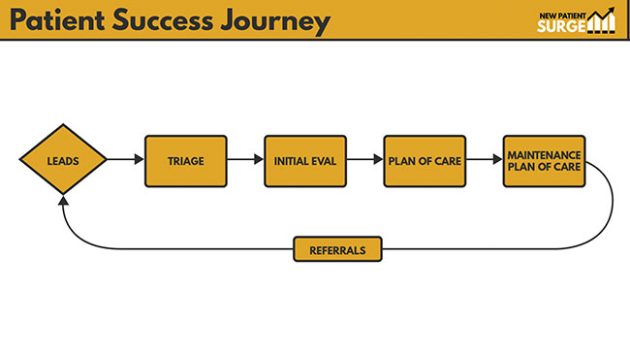
Features
Marketing
Operations
Patient Care
Grow your practice using the 6 stages of the patient success journey
June 7, 2022 By Brad Cote, RMT
 Having a well-defined, mapped out and tracked patient journey is key. Photo:© Dilok / Adobe stock
Having a well-defined, mapped out and tracked patient journey is key. Photo:© Dilok / Adobe stock One of the most important parts of a successful practice is understanding and building your practice around the patient success journey.
Having a well-defined, mapped out, and tracked patient journey is the key fundamental to why your practice is in business in the first place, and having a deep understanding of each one of the stages is a key to having a successful sustainable practice filled with patients you love treating and they will stay, pay and refer.
If you have not mapped your patient journey out yet this will be a foundational component to transform your practice and if you have this is will be a great opportunity to refine and optimize.
Before we get started, it’s important to note that the patient journey starts well before the patient schedules their first appointment.
The process actually starts when they first hear about your business and services, which is why having the right messaging, positioning within your community and offers are a critical part of a practices’ overall success.
How prospective patients view your services and business can be a critical factor in their decision on choosing your business over a potential competitor service such as different type of practitioner, a product such as painkillers or foam rollers, or simply doing nothing at all.
At this stage, refining your marketing message and community positioning, along with your offers to make sure the prospective patient understands the solutions that your services provide is critical.
For prospective patients who are ready to schedule right away, an initial evaluation is often easy enough for them to take action, we refer to these prospects as “hot” These prospects make up approximately 15%.
A larger grouping of prospective patients who are not quite ready to schedule yet as they may need to know more about your services or how you can help with equal between 35-45%. Offering these prospects a discovery visit or phone call often will allow them to build the know, like and trust needed for them to take the next step with you. We call these prospects “warm.”
Lastly, the largest segment of prospective patients is referred to as “cold.” These are the prospective patients who largely do not understand if or how you can help them and have preconceived ideas about what your services are for.
Offering these prospects a report on a specific condition such as low back pain is a great way to kick off the relationship in which you can establish yourself as the expert and build trust with them until they are ready to schedule. This is called the “Lead Stage,”and starts off the patient journey.
Ensure you are capturing the contact information of the prospects, segmenting them based on “hot, warm, cold” and creating a communication cadence that will nurture these prospective patients.
The next step in the patient journey is dependent on the type of practice you want to run. For example, a high-volume clinic may have direct booking from a prospective patient into your schedule, whereas a niche-style practice often will do a triage stage where they are able to gather more patient information prior to booking.
In my practice and for any of those running a private niche, experience-based practice, I always recommend implementing a triage stage where you can speak to the prospective patient first.This way you will have a complete understanding of if and how I can best help them in curate the experience so that way they will be excited to show up to their appointment to solve a problem.

A visual representation of the patient success journey.
Stage three is the Initial Evaluation. In this stage, the patient has scheduled with you to help them solve a specific problem. For example, pain relief increased range of motion, etc.
During the initial evaluation, it’s extremely important that we take a complete picture of the patient, including an in-depth health history review and assessment, to ensure we’re getting to the root cause of the chief complaint, followed by a custom-tailored treatment to the specific issues noted in the assessment. And lastly, a plan of care to ensure the patient is able to get long term relief and prevent further issues from coming back.
From my experiences, many therapists skip the treatment plan and leave the rebooking directly to the prospective patient. This may be because they are nervous about feeling salesy, not having the skill sets, or simply just too busy to go into the details. Unfortunately, the patient loses in this scenario, because they are not educated to know what the best next steps would be.
Having a clear documented plan of care, allows the patient to have clarity in terms of how they can resolve and improve the issues that they originally came in for.
Typically, most of our patients are coming in for a plan of care between four and eight weeks, depending on their condition.
If you are not advising on a plan of care based on the desired outcomes, you need to begin to incorporate this, and rebookings will happen consistently and patient compliance will skyrocket.
The fourth stage of the patient journey is the Plan of Care. The plan of care purpose is to address the initial issue of why the patient came to see you in the first place.
For example, a patient reaches out to you regarding their shoulder pain after playing volleyball. Their main goal is to overcome the pain, improve their range of motion, and get back to playing the sport that they love. During your treatment, you discovered that they had a shoulder impingement and strain which you provided a six-week plan of care, seeing you one appointment per week. As you go through the plan of care, if the treatment is working better, you may reduce or if it’s not going as well, we may refer out to another health practitioner, but their original plan of care is for the original issue the patient came in for.
The plan of care is important in having the patient understand the process in which recovery will be. The patient will understand the frequency of treatments, timelines, and specific homework. As a result, the patient is more likely to be compliant and active in their recovery and implementation.
If you are not advising on a plan of care based on the desired outcomes, you need to begin to incorporate this, and rebookings will happen consistently and patient compliance will skyrocket.
The next stage of the patient journey is often overlooked by many therapists and practice owners: the Maintenance Plan of Care.
The maintenance plan of care is extremely important because the majority of people are going to do activities that create imbalances and other unpleasantness. Especially if they are athletic or active. The purpose is serving to help the patient with the prevention and optimization of their current state.
Unlike the plan of care that is addressing the initial issue, the maintenance plan allows the patient to access you and your services and ensure they don’t end up having another more intensive issue in the future.
The last stage in the patient journey is Referrals. It is up to 12x more expensive to obtain a new patient than it is to retain one. Referrals can dramatically reduce this and help you to grow your practice.
The reality is that most practice owners do not have a system and strategy for consistently bringing in new referrals from satisfied patients.
When you receive a referral from a happy patient, the referral essentially kicks off the first stage of the patient journey (a lead) and that lead will then book an appointment, and the cycle continues. This process of systemizing consistent referrals decreases your patient acquisition cost and improves your profitability immensely.
Over 25% of our business comes from systemized referral systems.
Having a documented patient journey, allows you to optimize the communications needed at each stage, so that way a patient can successfully transfer from one stage to the next, ensuring that they get results.
Making sure that from a business perspective, you’re providing the best experience, and service possible, which in return will improve your consistency and bookings, and the profitability of your practice.
BRAD COTE is the founder of Link Performance Therapy, a successful cash pay private practice with a focus on athletes. He has grown his clinic from zero to 7-figures revenue within 18 months of operation using a combination of proven structures, systems and strategies that he now shares with healthcare business owners across North America who are looking to gain new patients and grow their business.
Print this page